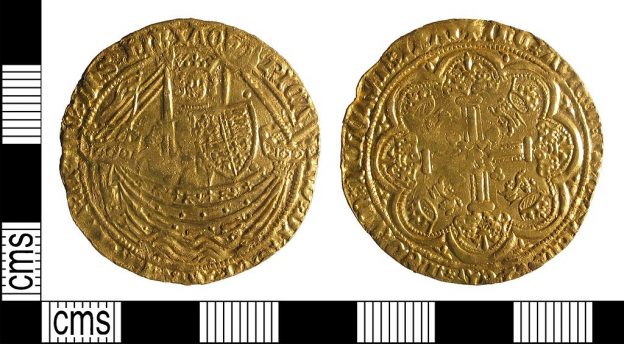Here’s an interesting little story which caught my attention this morning …
It comes from the record of a gaol delivery at Cambridge castle, on Monday 25th February,1387, and the narrative emerges from an indictment before justices of the peace. The story was that a certain John de Toft had, on Thursday 26th April, 1386, come to Elsworth (apparently a ‘small and lovely south Cambridgeshire village’) to the house of a man called John Cowhird. John Cowhird was probably not able to hird any cows at that point, as, we are told, he was very ill (maxima infirmitate detentus fuit). John Toft allegedly said that he could and would cure John Cowhird of this illness. What was more, he would do this ‘for the love of god and for charity’. A good deal, so John Cowhird probably thought … all he had to do was let John Toft borrow two golden nobles (coins as opposed to those with inherited titles, you understand …). These were not for John Toft’s personal use – perish the thought – but to make a charm. He said that he had enclosed the two nobles in a sheet of lead, and made a charm which he hung around John Cowhird’s neck. In reality, it was said, John Toft had taken the nobles.
The jury found him not guilty, so matters end abruptly, and we hear no more of poor John Cowhird and his malady (nor of how it was that a ‘cowhird’ – if, indeed that was JC’s actual job – had gold coins lying about the place). Did John Toft ‘get away with it’ and live to cheat another day? As ever, we can’t know.
We legal historians are used to such frustrations, and have to be fairly ‘glass half full’ types in research, taking what we can from the provoking records left so us. In that spirit, here are a few quick observations:
- On offences: this seems a rather interesting example of indictment for an offence of dishonesty beyond the usual mundane robberies and breakings and entries which are ten a (stolen) penny in these rolls. It is not dressed up as felony, despite the fact that two golden nobles would undoubtedly take it over the line into capital punishment territory: worth considering what that says about the contours of the various theft/fraud-adjacent offences in medieval common law.
- On ‘medicine’: well, there is a lot going on here! We don’t find out what poor old John Cowhird’s illness was, but we do see something about beliefs and practices relating to medicine at a fairly low social level. It is not hugely surprising that it was thought plausible for serious illness to be cured by charms and masses, or the intervention of an individual who is not described as having any sort of ‘professional’ qualification. The complaint here is not that JC was tricked by a clearly fraudulent promise, it is that JT did not create the charm in the way he promised, and in fact made off with the nobles. It would seem to have been seen as a plausible method of securing a cure, to hide away some valuable for a period of time. This sort of trick has come up in another 14th C magic/fraudulent practice case I spotted a while ago – and clearly this sort of ruse depended on people accepting the idea of a ‘hide something valuable’ route to a (miraculously!) positive outcome. From an amateur psychological point of view, that seems fascinating – in the context of this case, it tells us something about medieval ideas relating to ill health and recovery from it, doesn’t it? It seems to me as if the idea is that the supposedly temporary renunciation of contact with one’s valuable chattels is thought to have some influence over the course which the illness will take. Is this because it is a sacrifice/offering, or a demonstration of faith, both, neither? It also, perhaps, says something about medieval people’s attitude to their personal property: if being separated from it for a period, being unable to touch or see it, was a significant sacrifice, then doesn’t that tell us that they felt a very strong link to it? One of the things in legal history about which I often wonder is whether we underestimate the intimacy of the loss felt by those of past societies whose personal property was stolen: it is easy to read back the strict distinction now felt between offences against the person and against property, but is that accurate, when we travel back to earlier periods? I do wonder about this for various reasons. This case may well demonstrate a blurring of the border which modern lawyers and others would see between bodily harm and harm to property: somebody like John Cowhird might well accept that his physical wellbeing was linked to chattels, and, of course, there is a sense in which bodily survival and thriving is linked to the chattels which can be traded for food and shelter, even leaving aside the whole question of charms, magic and religion.
GS
25/3/2022
Image: more relevant than my usual efforts, isn’t it? It’s your actual noble, from the time of Richard II, courtesy of Wikimedia Commons.
